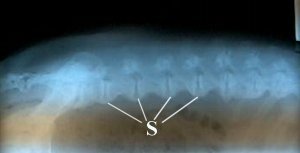
|
SPONDYLOSIS
DEFORMANS Note for Pet Owners: This information is provided
by Provet for educational purposes only.
You should seek the advice
of your veterinarian if your pet is ill as only he or she can correctly
advise on the diagnosis and recommend the treatment that is most
appropriate for your pet.
Topics on this Page:
|
Provet is conducting a Survey on Spondylosis, so if you have seen a clinical case please spend a few minutes completing our Survey. Thank YOU. SPONDYLOSIS SURVEY
Description
Spondylosis deformans (also called ankylosing spondylitis, or diskospondylosis*)
is a generalised disease of ageing secondary to the
degeneration of intervertebral disks which lie between the vertebrae in the
spine.
*NB The terms spondylitis or diskospondylitis should not be used to describe this specific condition as it is not an inflammatory disease Inflammatory causes of disk disease do also occur in humans as well as dogs and cats. See diskospondylitis.
Cause
The precise cause of spondylosis is not understood, but it is a non-inflammatory
disease , the spinal changes that occur in
spondylosis are a response to instability in the intervertebral disk spaces of
the spinal column.
Mapping of the canine genome is well under way and if there is a gene that is responsible for the occurrence of spondylosis it may be identifiable, however the condition it is unlikely to be a simple inherited problem.
Too much vitamin A intake has been implicated in some cases of spondylosis in cats (this is usually due to feeding a lot of fresh liver) - and Provet is conducting an investigating into the possibility of such a relationship in dogs.
Breed Occurrence
Spondylosis occurs at all ages but increases in incidence in older animals.
Although many reports suggest that spondylosis occurs more frequently in some
breeds such Boxers and large breeds of dog, this has recently been disputed, and
in fact it is now thought that "all dogs and cats , regardless of breed or
sex, will develop a degree of spondylosis if they live long enough".
Signs
Spondylosis is often present in animals without causing any clinical signs. If
an animal shows signs they are due to pressure of the new bone on spinal nerves,
or on the spinal cord itself.
Complications
Diagnosis
On XRays of the back spondylosis is characterised by the formation of new
bone (osteophytes or spurs) around the affected disk, and occasionally complete
bridges can form causing stability across the disk space.

Bone
(S) bridging the spine of an old dog with spondylosis
Treatment Prognosis Long term problems
Treatment is given to alleviate symptoms when they do occur eg for pain relief.
There is no generally accepted satisfactory surgical treatment. If the new bone
is removed it simply reforms.
The prognosis is guarded because the disease cannot be totally treated.
Updated September 2014
d>